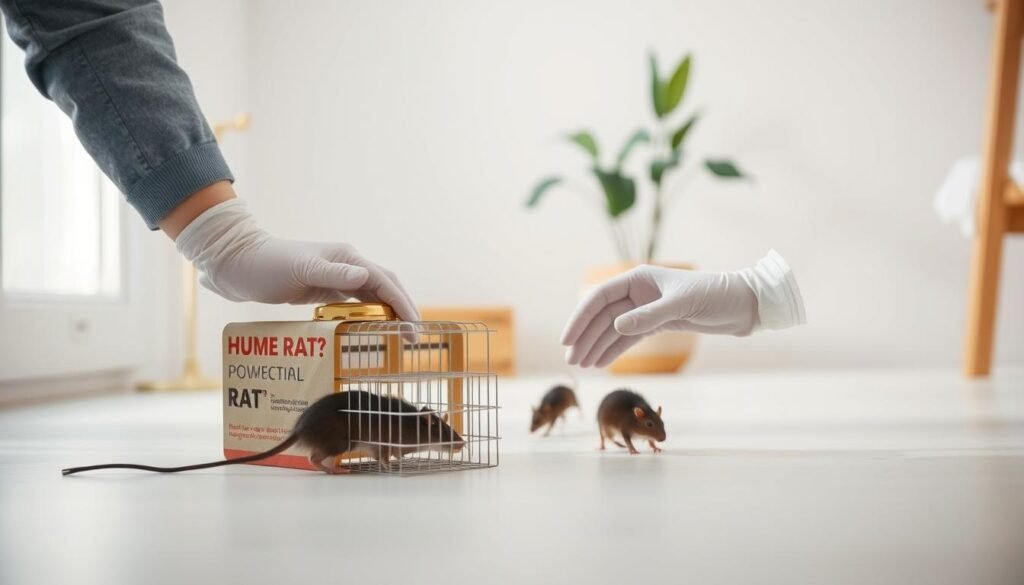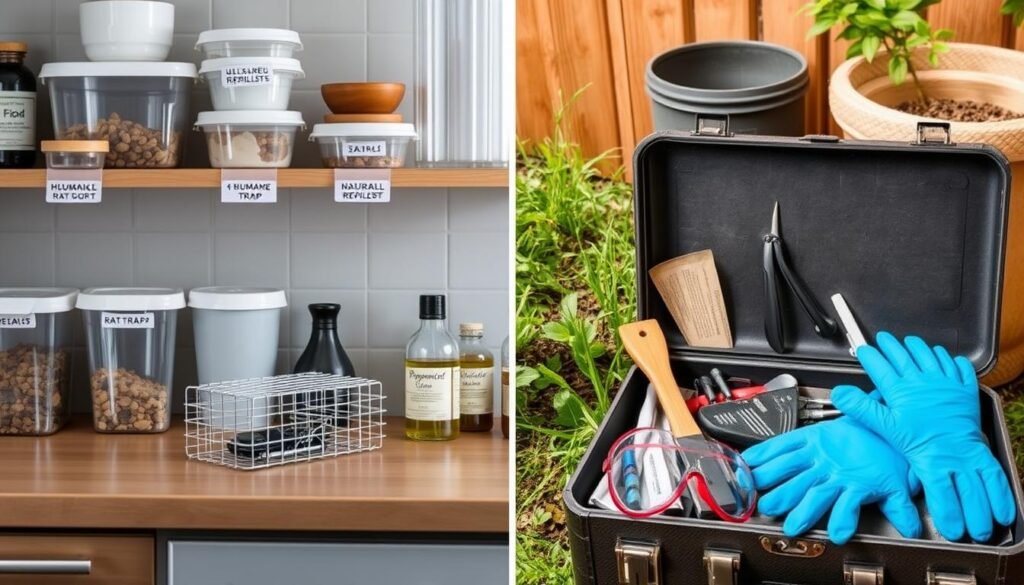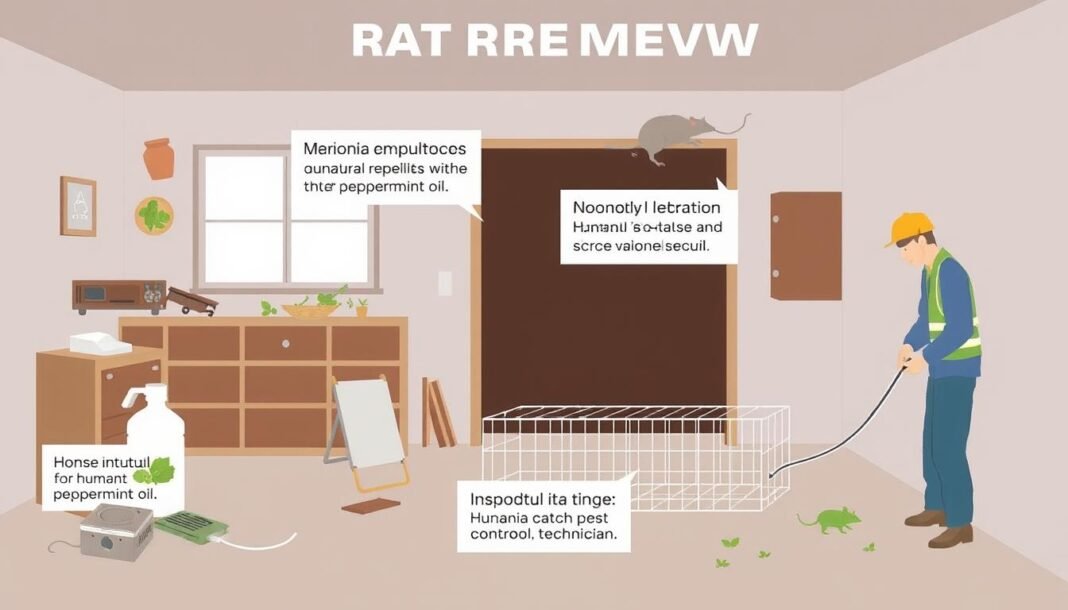When dealing with rats, it’s critical to act fast. These rodents can seriously harm your health and damage your property. Knowing how to remove rats effectively can make your home safer and healthier. In this piece, we’ll cover different ways to control rodents. From hiring pest experts to using do-it-yourself strategies, it’s important to address rat problems quickly. Doing so ensures your home remains a safe place.
Key Takeaways
- Address rat infestations quickly to prevent health risks.
- Explore various effective rat removal methods for best results.
- Delay in rodent control can lead to more serious property damage.
- Consider both professional services and DIY approaches.
- Monitor your home regularly for signs of rat presence.
Understanding the Rat Problem
Knowing how to spot a rat infestation is key to keeping your home safe. Rats can sneak into homes, causing problems and hazards. It’s important to understand their behavior to fight off rodents effectively. Spotting the signs early on can help avoid worse issues later.
Common Signs of a Rat Infestation
It’s crucial for homeowners to watch for rat infestation signs. Some common indicators include:
- Droppings: Small, dark pellets often found in cabinets or along walls.
- Gnaw marks: Chewed surfaces may reveal rat presence.
- Nocturnal noises: Sounds at night may mean rats are around.
- Nesting materials: Finds like shredded paper suggest rat nests.
The Dangers of Rat Infestations
Rats pose serious health risks. They carry diseases harmful to humans. Here are some diseases rats can spread:
- Hantavirus: A severe respiratory disease from rat droppings or urine.
- Leptospirosis: A bacterial disease from water rats contaminated, very harmful.
- Salmonella: Causes food poisoning, spread through tainted food or surfaces.
Health experts stress the importance of fighting rodents to protect public health. Learning about rat behavior helps create effective defenses for homes and neighborhoods. If you see signs of rats, act fast to keep everyone safe and healthy.
Why Choose Professional Rat Removal?
Finding rats in your home is more than an annoyance. It’s essential to choose professional 除老鼠. These experts ensure the rats are removed effectively. Plus, you’ll have peace of mind knowing professionals are in charge.
Advantages of Expert Pest Extermination
Professional pest extermination comes with big benefits:
- Comprehensive Assessment: Experts can spot infestation signs you might miss.
- Targeted Solutions: They use specific methods for your rodent problem, increasing success.
- Long-term Prevention: Experts get rid of pests and help prevent future invasions.
- Safety Considerations: They safely use pesticides and traps, keeping kids and pets safe.
When to Call in the Professionals
Knowing when to call pest control is important. Look for these signs:
- Visible rodent droppings or nesting materials.
- Frequent rat sightings during the day.
- Noises in walls or ceilings at night.
- Gnaw marks on food packaging or furniture.
DIY Rat Removal Techniques
Many homeowners look for ways to handle rat problems by themselves. Trying DIY rat removal techniques can be cost-effective and provide quick results. In this guide, we’ll discuss the necessary tools for trapping rats. You’ll also learn how to make your own rat repellents. These methods are natural and safe for your home.
Essential Tools for Effective Rat Trapping
Effective rat trapping requires specific tools. Here’s a list of what you might need:
- Snap traps: Simple and effective, they kill rats quickly.
- Electric traps: These deliver a humane shock to kill rats instantly.
- Bait stations: Safe for bait storage, they attract rats without endangering other animals or pets.
- Gloves: Wear gloves to prevent your scent from deterring rats.
Correctly placing, baiting, and maintaining these tools is key. Doing so makes your DIY efforts more successful.
Creating Homemade Rat Repellents
For natural deterrents, homemade repellents work well. Here are two easy recipes:
- Peppermint oil spray: Blend 10-15 drops of peppermint oil with water in a spray bottle. Target areas where rats might get in.
- Vinegar solution: Mix equal parts white vinegar and water in a spray bottle. Use it at rat entry points to keep them away.
These DIY repellents are great for driving rats away. Plus, they’re safe around kids and pets. Using these tips can help you maintain a rat-free space naturally.
Humane Rat Removal Practices
Adopting humane rat removal practices is crucial for those who want to coexist with local wildlife without rats in their homes. These practices include humane trapping and ethical pest control. They help us treat all living creatures with kindness.
Understanding Humane Trapping Methods
Humane trapping methods catch rodents safely. Catch-and-release traps are a popular option. They capture rats without hurting them. The benefits of this method are:
- Less stress for the animal
- Lower risk of spreading disease
- Support for ethical pest control
When choosing traps, make sure they are humane and big enough for the rats in your area.
How to Release Rats Safely
Releasing rodents safely is key in humane rat removal. After catching them, it’s important to take them far from homes. Consider the following:
- Pick a release spot at least a mile from your home.
- Choose a natural area, like woods or fields, away from people.
- Release them when the weather is good, avoiding extreme cold or heat.
- Look around for other wildlife to make sure the rats can fit in peacefully.
Using these methods helps you handle pest control in a caring way. It also supports the protection of local wildlife.

Implementing Rat Exclusion Strategies
To keep your home free of rodents, it’s crucial to use rat exclusion methods. Identifying potential entry points is a big step in pest prevention. Inspecting your home carefully will help you make it rodent-proof.
Identifying Entry Points in Your Home
Start by looking for holes in walls, windows, and the foundation. Rats can fit through tiny spaces, as small as a quarter. Pay special attention to:
- Basement windows
- Pipe entrances
- Attic spaces
- Garage doors
- Vents and exhaust fans
Effective Sealing Techniques for Rat-Proofing Homes
After finding where rats can get in, sealing these spots is key for protection. Use materials like:
- Steel wool for small gaps
- Caulk for sealing cracks
- Plywood for larger openings
- Wire mesh for vents
Combining these sealing methods with frequent checks can greatly lower rat infestation risks. Always keep up with these defenses to prevent pests.
| Entry Point Type | Recommended Sealing Material |
|---|---|
| Small Gaps | Steel Wool |
| Cracks in Walls | Caulk |
| Larger Holes | Plywood |
| Vents | Wire Mesh |
Effective Rat Removal: Best Practices
Dealing with rats requires careful planning. It is crucial to follow the best practices for rat removal. This includes both trapping rats and stopping more from coming in. Homeowners can solve the problem now and avoid it later this way.
Combining Trapping and Exclusion for Success
For best results in removing rats, it’s key to use both trapping and blocking their entry. Catching rats reduces their number. Blocking their paths stops others from entering. Here are the must-do steps:
- Identifying areas where rats frequent.
- Using a combination of snap traps and live traps.
- Sealing entry points to avoid re-infestation.
Monitoring and Maintenance Post-Rat Removal
Once you’ve taken steps to get rid of rats, keep an eye out. Regular checks help see if your plan works and catch any new rat signs early. For a home without rodents, remember to:
- Conduct monthly checks for new droppings or gnaw marks.
- Keep food storage areas clean and secure.
- Regularly evaluate how well your blocking out rats works.

Following these actions improves your chances of getting rid of rats for good. It also helps keep your home safe from future infestations. Adopting these measures is key to a rodent-free home.
| Method | Description | Effectiveness |
|---|---|---|
| Snap Traps | Quickly kills rats upon contact | High |
| Live Traps | Catches rats unharmed for safe release | Moderate |
| Exclusion | Seals entry points against future infestations | Very High |
Choosing the Right Rat Repellents
Facing a rat problem means you need the best solution to repel these pests. You can choose from natural to chemical repellents. Each choice has its pros and cons. Factors like safety, how they affect the environment, and how well they work play a big role.
Natural vs. Chemical Repellents: Which is Best?
Natural repellents use things like essential oils and spices. Think peppermint and cayenne pepper. They’re good for the earth and safe for families and pets. You can place them where rats hang out. This creates a smell barrier that rats don’t like. Many find these methods work well, especially when used with other pest control steps.
Chemical repellents, on the other hand, are made with synthetic stuff to keep rats away. They work fast but can be risky. They might be harmful to pets and other wildlife. You must use them right, following the maker’s directions to avoid problems.
Deciding between natural and chemical options depends on several things:
| Factor | Natural Rodent Repellents | Chemical Rodent Deterrents |
|---|---|---|
| Environmental Impact | Low, biodegradable | Variable, potential harm to ecosystems |
| Safety Personal Use | Generally safe, low risk | Higher risk, requires caution |
| Initial Effectiveness | Moderate, may require reapplication | High, immediate results |
| Cost | Typically lower, DIY friendly | Various price points, often higher for branded options |
In the end, knowing the difference between natural and chemical repellents helps you choose wisely. Each method has its benefits, depending on your needs and preferences.
Preventing Future Infestations
Taking steps early is key to stop rat problems in your house. By inspecting your home regularly, you can find and fix weak spots quickly. This stops rats from getting in. Getting advice from pest experts can help you know what to look for. They can show you where rats might get in or build nests.
Regular Home Inspections for Early Detection
Looking over your home often can greatly lower the risk of rats moving in. Check for rat signs like droppings or chew marks in quiet places. Also, walk around your home’s outside to find where rats could enter. Finding these spots early can keep small issues from getting big. Hiring a pro can help too, as they can suggest ways to keep rats away that work best for your home.
Maintaining Cleanliness to Deter Rodents
Keeping your home clean is very important to keep rats away. Good habits like storing food right and managing trash well can make your home less inviting to rats. Make sure food is in sealed containers and clean up well after eating. Adding these steps to your daily life is an easy but strong way to protect your home from rats.
